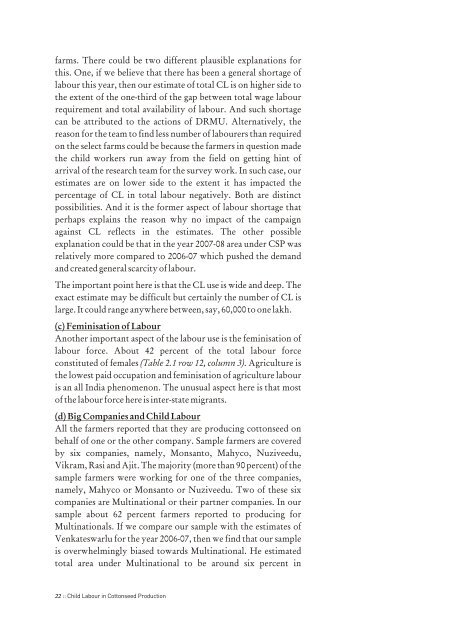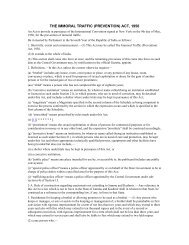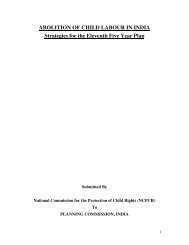Child Labour in Cottonseed Production by Ashok Khandelwal
Child Labour in Cottonseed Production by Ashok Khandelwal
Child Labour in Cottonseed Production by Ashok Khandelwal
You also want an ePaper? Increase the reach of your titles
YUMPU automatically turns print PDFs into web optimized ePapers that Google loves.
farms. There could be two different plausible explanations for<br />
this. One, if we believe that there has been a general shortage of<br />
labour this year, then our estimate of total CL is on higher side to<br />
the extent of the one-third of the gap between total wage labour<br />
requirement and total availability of labour. And such shortage<br />
can be attributed to the actions of DRMU. Alternatively, the<br />
reason for the team to f<strong>in</strong>d less number of labourers than required<br />
on the select farms could be because the farmers <strong>in</strong> question made<br />
the child workers run away from the field on gett<strong>in</strong>g h<strong>in</strong>t of<br />
arrival of the research team for the survey work. In such case, our<br />
estimates are on lower side to the extent it has impacted the<br />
percentage of CL <strong>in</strong> total labour negatively. Both are dist<strong>in</strong>ct<br />
possibilities. And it is the former aspect of labour shortage that<br />
perhaps expla<strong>in</strong>s the reason why no impact of the campaign<br />
aga<strong>in</strong>st CL reflects <strong>in</strong> the estimates. The other possible<br />
explanation could be that <strong>in</strong> the year 2007-08 area under CSP was<br />
relatively more compared to 2006-07 which pushed the demand<br />
and created general scarcity of labour.<br />
The important po<strong>in</strong>t here is that the CL use is wide and deep. The<br />
exact estimate may be difficult but certa<strong>in</strong>ly the number of CL is<br />
large. It could range anywhere between, say, 60,000 to one lakh.<br />
(c) Fem<strong>in</strong>isation of <strong>Labour</strong><br />
Another important aspect of the labour use is the fem<strong>in</strong>isation of<br />
labour force. About 42 percent of the total labour force<br />
constituted of females (Table 2.1 row 12, column 3). Agriculture is<br />
the lowest paid occupation and fem<strong>in</strong>isation of agriculture labour<br />
is an all India phenomenon. The unusual aspect here is that most<br />
of the labour force here is <strong>in</strong>ter-state migrants.<br />
(d) Big Companies and <strong>Child</strong> <strong>Labour</strong><br />
All the farmers reported that they are produc<strong>in</strong>g cottonseed on<br />
behalf of one or the other company. Sample farmers are covered<br />
<strong>by</strong> six companies, namely, Monsanto, Mahyco, Nuziveedu,<br />
Vikram, Rasi and Ajit. The majority (more than 90 percent) of the<br />
sample farmers were work<strong>in</strong>g for one of the three companies,<br />
namely, Mahyco or Monsanto or Nuziveedu. Two of these six<br />
companies are Mult<strong>in</strong>ational or their partner companies. In our<br />
sample about 62 percent farmers reported to produc<strong>in</strong>g for<br />
Mult<strong>in</strong>ationals. If we compare our sample with the estimates of<br />
Venkateswarlu for the year 2006-07, then we f<strong>in</strong>d that our sample<br />
is overwhelm<strong>in</strong>gly biased towards Mult<strong>in</strong>ational. He estimated<br />
total area under Mult<strong>in</strong>ational to be around six percent <strong>in</strong><br />
22 :: <strong>Child</strong> <strong>Labour</strong> <strong>in</strong> <strong>Cottonseed</strong> <strong>Production</strong>





